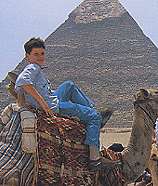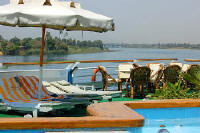|
Cruising on the Nile River |
Visiting Cairo and Luxor
Review and Photos by Karen,
Christopher, and Alan Fox
Cairo
Safety Conrad
International Hotel Sonesta
Sun Goddess Luxor Temple Karnak Temple
Valley of the Kings Valley of the Queens
Tombs
We
began our initial descent into
Cairo
just after 8am, as the pilot announced that the temperature on the ground was
already 90 degrees and climbing. Our overnight flight from Johannesburg had
taken us from one end of the African continent to the other, and from winter to
summer--in the Sahara Desert. The view from the plane was of sand, for as far as
the eye could see.
We'd
been traveling for nearly 24 hours since leaving Savute Elephant Camp in
Botswana, but our excitement at finally reaching the Land of the Pharaohs was
impossible to contain. Ahead of us that great, ancient city was coming to life
as it had every day for more than a thousand years.
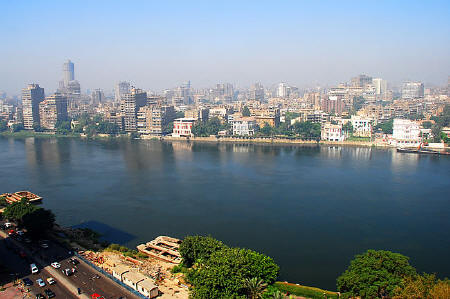
Cairo has one of the world's busiest airports, and as we walked into the
terminal from the tarmac, we found a sea of people swarming a handful of
immigration desks. Most visitors (including Americans) must have a visa and
obtain it upon arrival, but before we could look for the end of the line, a
representative from African Travel stepped forward.

Tourism Buses arrive at Karnak Temple
Not
surprisingly, most of the buildings in Cairo are old, and in some areas they
seem to be collapsing from the top down. Along the elevated freeway, we saw
countless four- to six-story buildings crowned with nothing more than a section
of wall and some protruding rebar.
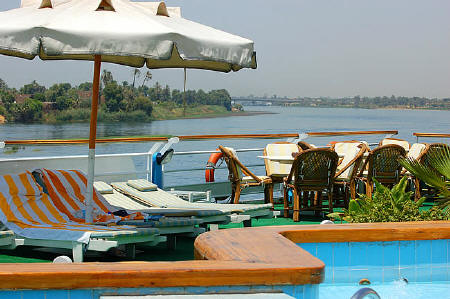
On board the Sun Goddess, docked in Luxor
The
Sun
Goddess is one of five Sonesta ships on the Nile, all of which offer 3-7 day
voyages between Aswan and Luxor. It's not new, but it is well-maintained and
well-run and appeared to be among the best of the many ships we saw.
The
boat has four decks, including the observation deck on top with pool and bar, a
dining room, lounge, Internet room, conference room and a couple of shops. All
62 cabins and suites have windows.
The Sun
Goddess was only about half full, as summer is not the ideal time to visit
Egypt. True, it is sunny, but then it is always sunny, and in July we found
daily high temperatures between 115 and 120 degrees. We carried water with us
always, and Hany arranged for most of our walking explorations to happen in the
early morning, late afternoon and after sunset.
Luxor
We
spent two days and one night on the boat in
Luxor,
a place with archaeological sites that rival any on Earth. We visited
Luxor Temple
and
Karnak Temple,
massive structures built more than 3,000 years ago, and crossed the Nile to the
Necropolis,
which includes the
Valley of the Kings
and the
Valley of the Queens.
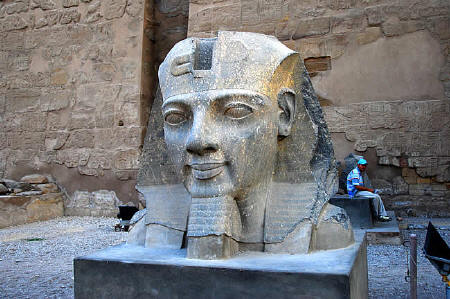
Head of
Colossus,
Luxor Temple
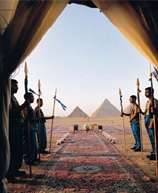 For a
period of nearly 500 years, from the 16th to 11th century B.C., Egyptian
Pharaohs were buried in the Valley of the Kings, in elaborate tombs dug out of
solid rock. Some of their wives and children were buried in the nearby Valley of
the Queens.
For a
period of nearly 500 years, from the 16th to 11th century B.C., Egyptian
Pharaohs were buried in the Valley of the Kings, in elaborate tombs dug out of
solid rock. Some of their wives and children were buried in the nearby Valley of
the Queens.
Pharaohs began working on their
tombs
as soon as they were crowned, as elaborate tributes to themselves and to the
gods that would welcome them to the afterlife. The walls of these multi-room
tombs were engraved with hieroglyphs and brightly painted.
When
their bodies had been mummified, the rulers were sealed in their tombs along
with treasure and various possessions that would be needed in the next world.
Many of these tombs are amazingly well preserved and nine are lit and open to
the public, including the most famous of them all, the tomb of Tutankhamun.
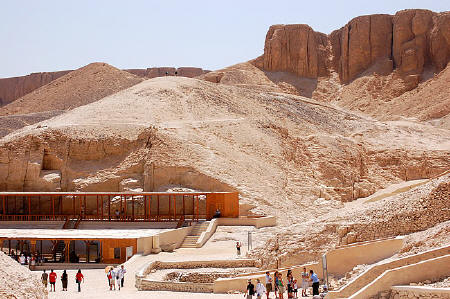
Tomb Entrance, Valley of the Kings
It is a
smallish tomb, most likely because he died at a young age, before it was
completed. Somehow tomb robbers lost track of it after some minor artifacts had
been removed, and it was buried and forgotten for centuries. When it was finally
unearthed in 1922, the tomb of Tutankhamun contained a wealth of artifacts
including a solid gold funeral mask that is often used to symbolize the greatest
treasures of Egyptian antiquity.
By this
stage of the trip, we had come to truly appreciate the knowledge and
storytelling ability of Hany, our private Egyptologist, whose enthusiasm over
the subject was infectious. In flawless English he read and interpreted the
hieroglyphs
in temples and tombs, and he peeled back layer upon layer of history in a way
that kept things interesting.

Hieroglyphs at Karnak Temple
We
learned that ancient Egyptian laws were based on a common-sense view of right
and wrong and the pursuit of truth, order, balance and justice. Egypt produced
the world's first architects, mathematicians, scientists and doctors, and the
first massive buildings made of stone. Egyptians were the first to use columns
of stone to support temples and the first to pave roads. They treated the human
body to prepare it for the afterlife. They produced the world's first wine and
beer.
"After
5,000 years, there is nothing new under the sun," he once said, and after
listening to his arguments, I could not disagree.
![]()
Continue with Part 2: Cruising South on the
River Nile
Return to the Travel Reviews Directory
For a slideshow of
photos from this leg of the tour, click
here.
To see the itinerary
and prices for
Royal Egyptian
departures,
click
here.
For a list of all Egypt
tours and Nile cruises, click
here.
For a map of Egypt and
the Nile, click
here.
Continue with Part 2: Cruising South on the
River Nile
